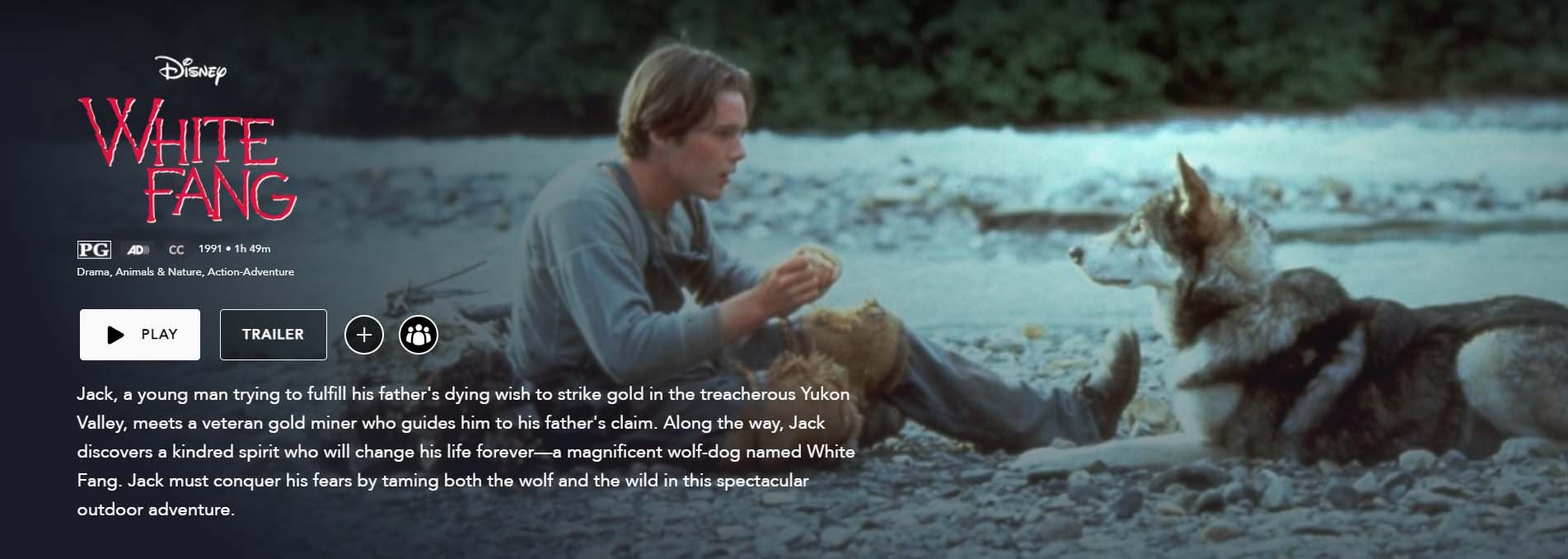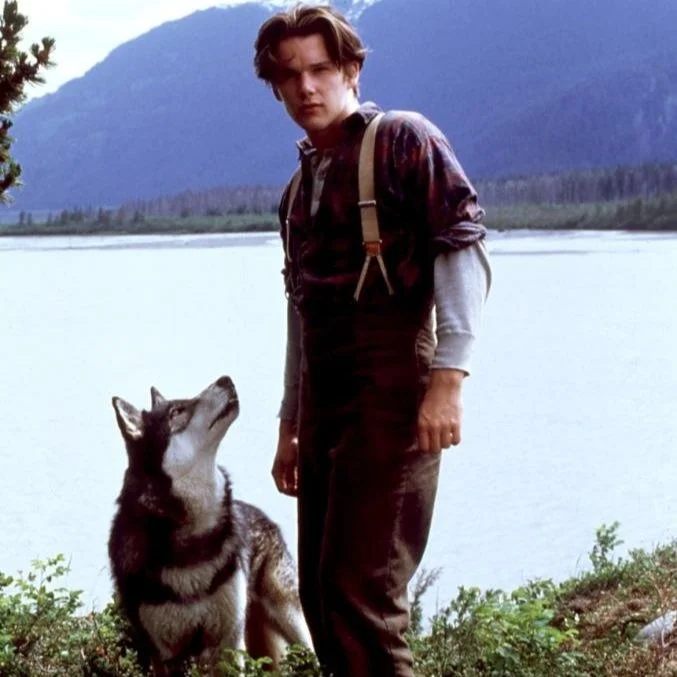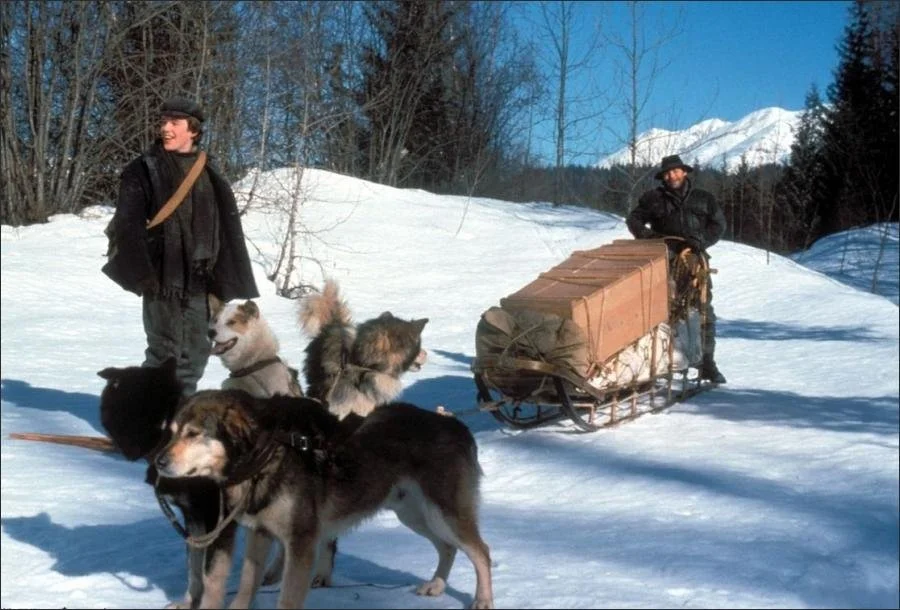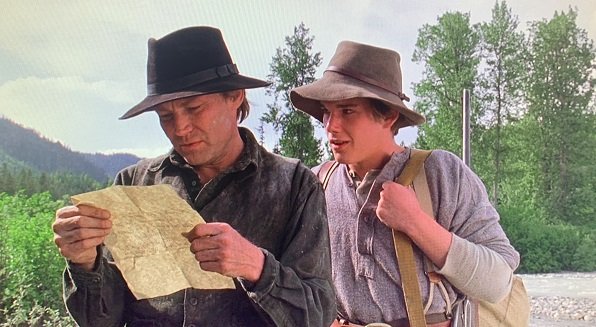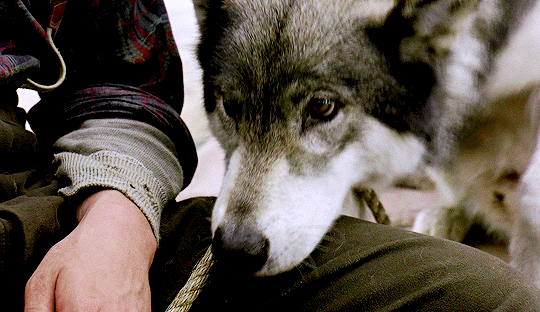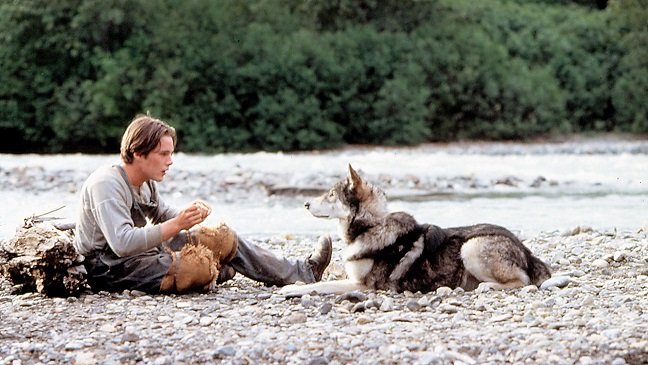Review: White Fang (DMC #89)
This week we explored the snowy landscapes of Canada and Alaska in the 89th film of our challenge—White Fang. After a few weeks of revisiting childhood classics, it was a new one for us to dive into. If, like us, you haven’t seen this film, you can find our synopsis below. For the rest of you, scroll down to check out our review of this tale of man and (wolf)dog.
Synopsis
It is the period of the Klondike Gold Rush. Deep in the woods of the Yukon Valley, a mother wolf feeds her pup. Far from the woods, a young man named Jack Conroy arrives in Alaska from San Francisco to begin searching for his recently deceased father’s gold mining claim. He first plans to meet up with an old acquaintance of his father’s named Alex Larson. Jack refuses company from a ruthless dogfighter named Beauty Smith, though not without Smith and his goons managing to pickpocket him. Jack eventually meets Alex as well another musher named Clarence “Skunker” Thurston, who also knew Jack’s father. Jack asks them to help him find the claim, promising a cut. Though Alex is reluctant, he agrees to take Jack as far as Klondike City. As the group journeys across the frozen valley, they are followed by a large pack of wolves looking for prey. The next day, Jack falls through a frozen lake while trying to retrieve the group’s supplies and cargo including the frozen body of Alex’s comrade, Dutch. Alex and Skunker rescue Jack who recovers by the warmth of a fire that night while Alex and Skunker review the remaining supplies. The wolves soon arrive; a female, the mother of the cub seen earlier, lures one of the sled dogs, Digger, away. Another wolf scares the other dogs into the woods. Skunker shoots the female wolf and runs after Digger, but he and Digger are killed by the pack. Later that night, the wolves return again and almost attack until they are frightened off when Jack and Alex swing burning tree branches at them. Their troubles only continue into the morning when the wolves attack them once more. They are saved in the nick of time by another group of mushers, one of whom manages to fatally shoot the female wolf. Hobbling back to her den, the female wolf dies from her wounds while her pup remains at her side. The pup is forced to leave and fend for himself. He and Jack cross paths briefly along the way. Eventually the pup comes across a dead animal in a trap. While trying to retrieve the animal, the pup becomes snared in a trap set by a group of Native Americans, led by Grey Beaver. Grey Beaver frees the pup and decides to keep him after realizing he is part dog. He names the pup “Mia Tuk” which translates to “White Fang.”
Jack and Alex bury Dutch at Dutch’s former claim and continue their trek to Klondike City, where Alex attempts to part ways with Jack. Alex meets up with his lover, Belinda Casey, who owns a local pub. Jack arrives at the pub and meets Belinda who later on invites him to dinner with her and Alex. Jack persuades Alex to accompany him on his continued quest for his father’s claim. In the spring, they travel by boat to the Native Americans’ village and meet with Grey Beaver, who invites them to stay. Jack is fascinated by White Fang, who has grown into an adult. Grey Beaver discourages Jack from petting him, saying dogs are only meant to be used for work. However, Jack remains adamant that White Fang can learn to be friendly. The following morning, Jack is pursued by a bear while exploring outside the village. He takes cover under a pile of wood and is nearly mauled by the bear when White Fang rushes to his defense and chases the bear off. Jack gives White Fang some jerky as thanks for rescuing him. He and Alex continue on their way and finally find Jack’s father’s cabin and gold mine. Meanwhile, Grey Beaver and White Fang travel to Klondike City and run into Beauty Smith and his gang. Smith goads White Fang into a fight with his dog while Grey Beaver is inside a store. White Fang wins, but when Grey Beaver returns, Smith demands compensation for his dog and forces Grey Beaver to surrender White Fang. The gang forces the wolfdog to undergo a brutal and abusive training regimen. Smith enters White Fang into illegal dogfighting matches where White Fang becomes undefeated and makes Smith a lot of money. Back at the mine, Jack’s prospects aren’t starting off well. As he and Alex continue to bond, Jack offers to teach Alex how to read and Alex offers to help Jack with the mine in exchange. Some time later, the two head into town to pick up supplies. Coincidentally, a dogfighting match is taking place that day. Smith enters White Fang into the ring against a bulldog named Cherokee, who belongs to Smith’s rival, Mr. Sykes. Cherokee proves to be more than a match for White Fang; the wolfdog soon finds himself at Cherokee’s mercy when the bulldog latches onto his throat. Jack arrives at the match while exploring town and is able to save White Fang. Police arrive on the scene and scare the spectators away. Jack claims White Fang as his own as compensation for the money Smith stole from him before, with Alex holding Smith at gunpoint to keep him at bay.
Jack tends to White Fang’s wounds with Belinda’s help. Alex believes Jack is wasting his time trying to tame White Fang but Jack is certain he can succeed. When White Fang destroys part of the cabin, Jack attempts to calm him down. The sight of Alex holding a stick in his hand (which was what Smith did during his brutal training) frightens White Fang and he attacks Jack. Time passes, and through Jack’s patience and kindness White Fang overcomes his aggression; the two become friendly companions. Jack trains White Fang to help him and Alex mine for gold. One day, a section of the mine collapses while Jack and White Fang are inside, burying Jack beneath debris. Luckily White Fang and Alex dig him out. When the group walks out of the mine, Alex notices gold dust on White Fang’s paw. They go back inside the mine and discover the collapse revealed a huge section of pure gold ore. Jack takes some of the gold into town to have it tested and it is confirmed that he and Alex are rich. Meanwhile, Smith enacts revenge on Jack by attacking the cabin the next morning. He and his gang attack the cabin with gunfire before setting it ablaze. Jack and Alex take cover and White Fang attacks one of Smith’s men, Tinker, causing him to discharge his gun and shoot Luke, Smith’s other man. Smith tries to shoot White Fang but is quickly subdued by the wolfdog until Jack orders White Fang to stop. Jack and Alex hold the men at gunpoint and make them haul ore into town on the way to the Mounty as punishment, which causes the townspeople to openly mock Smith and his goons. Later, Alex tells Jack that he and Belinda are planning to return to San Francisco. They offer to take Jack back with them, though Alex reminds Jack that White Fang will not be able to come with them. Realizing the truth of this, Jack releases White Fang into the wild. At first he’s unable to drive White Fang away, but when he brandishes a stick in his hand the wolfdog runs away in fright. Jack accompanies Alex and Belinda to the ship that will take them to San Francisco. Before he can board, Jack ultimately decides that he can’t leave his father’s claim just yet. Alex nods in approval and says that this is what Jack’s father would have wanted. Jack returns to the cabin and tries to call White Fang, though initially to no avail. While working on the roof of the cabin, Jack sees White Fang come out of the woods and joyfully runs towards him. The two are happily reunited and run off to play in a nearby field.
Thoughts Before Watching
Kevin: I heard of White Fang before and later realized that what I was actually thinking of was the 2018 animated remake on Netflix. I had no idea that there was an earlier version of the story created by Disney, nor did I even realize just how popular the original novel by Jack London apparently was. Once more, however, I find myself not all that excited for this, no matter how popular the novel is. As much as I enjoy films with animals in them, most, if not all of the animal-centric live action movies we’ve seen so far haven’t quite hit the mark as far as emotional engagement and re-watch value. Let’s see if this one is any different.
Megan: Like Kevin, I’ve never read the book or seen this movie before. In fact, I’ve never even seen any other films based on Jack London’s book White Fang before (but now that I’ve looked up a trailer for the Netflix film, I may have to check that one out after we watch this one). I’m more familiar with film adaptations of Jack London’s book The Call of the Wild. (I also have a feeling I might have read that book before, though it would have been ages ago, and even between the book I may have read and the one or two movie adaptations I’ve seen, I definitely couldn’t tell you what it’s about other than some guy in the wilderness with a wolf…I think). Going into this viewing of White Fang, I’m mostly just hoping the dog doesn’t die because I can’t take a sad movie right now.
Thoughts After Watching
What’s the plot here?
Kevin: One thing Megan and I both agreed on after finishing this was that the plot was hard to follow. The film seems to struggle with creating a cohesive narrative. For me, I think it doesn’t know what its main purpose is. Is it about Jack finding his father’s claim or is it about the bond between Jack and White Fang? It seems like it should be both but I’m just not convinced the film did a great job showing that. The film initially presents the stories of its two main characters as separate narratives, with the adventures of White Fang and his struggles for survival on one side and the journey of Jack Conroy looking for his claim on the other. Half the movie is spent keeping these characters apart, with only one highly convenient moment where the two briefly gaze at each other from across a river before officially meeting later on. To be honest, this moment personally took me out of the movie a bit. It was already obvious that the two characters would eventually join up that I found it odd to have them meet here, however brief it was. It offered nothing new to the story nor any development to the characters and didn’t serve as an interesting callback later on (I personally think it would have been better to have either Jack or White Fang—or both of them—recognize each other, but there’s no indication that either of them did). It took me out of the story because it seemed too much of a coincidence that Jack would later come across this very same wolfdog.
Another reason for the plot meandering so much is how it treats Jack and White Fang’s relationship. For being the main relationship in the film, I thought we were going to see these two come together much sooner than it actually occurred. Apart from their one brief encounter, the two don’t “officially” meet until almost halfway through the movie. There is a little bonding when White Fang saves Jack from the bear, but then we don’t see the pair of them come together until the last third of the film’s runtime, and even then, Jack’s successful taming of White Fang happens when there’s around 25 minutes left. These last minutes don’t focus solely on the relationship between the two, since it still has to remind us that Alex is a character in this film, too, and it has to remind us that Beauty Smith and his gang are still out there plotting revenge. As a result, there’s not that much time actually given to Jack and White Fang together. This is why I said I’m not sure whether the film’s focus is on Jack finding his father’s claim or his friendship with White Fang. Despite being the titular character, White Fang’s story is so separated from Jack’s at first that when the two come together it seems less natural and more of an obligation from the writers. From what I could research, the original novel focuses much more on White Fang and the animals of the forest than it does on its human male character. I’m guessing the filmmakers of the 1991 movie decided to bring their version of the human character more center stage. In the end, I get the feeling White Fang’s story is supposed to be the A plot and Jack’s is the B plot. With the way the film is presented, it almost appears to be the opposite, but it’s still not clear.
The struggle to adapt a novel about a wolf-dog
Megan: Initially, while watching this movie, I suspected that part of the reason the plot was so hard to follow was because the filmmakers were trying to visually show internal character thoughts or emotions that had been conveyed in the novel. For example, there were many moments where the camera stayed on Jack’s facial expression, but the emotion was a bit hard to read. We could kind of deduce what he was thinking after piecing together those looks with the action before and after those shots, but had we been reading a novelized description we would have had a much better understanding of what was going through his mind. It’s as my screenwriting instructors keep saying—stop trying to convey characters’ thoughts or emotions through “a look.” Give the actors an action to perform that will tell the audience what that character is thinking or feeling. Films are a visual medium. If the audience can’t see it or hear it, they’re not going to understand it. Novels are much better suited for expounding on a character’s inner thoughts and emotions.
However, after watching the movie, I looked up a plot summary of the novel White Fang. Turns out the struggle wasn’t as simple as trying to adapt internal thoughts or emotions to a visual medium. Nope. It’s much bigger. The movie is nothing like the novel at all! Sure, there are some similarities, but the film’s entire plot was overhauled to make Jack a major player in this story when his character equivalent, Weedon Scott, is only in the book for the last few chapters of the story. As Kevin already mentioned, the wolf-dog White Fang is the real protagonist of the novel, yet he’s given a B-story role in this film. The attempt to meld together pieces of White Fang’s story from the original novel with the new story constructed for Jack, combined with too many moments where the filmmakers relied heavily on audiences catching what’s happening in a quiet look, leads to a scatter-shot plot that’s difficult to keep track of. True, Kevin and I were both actively taking notes while watching, so our eyes were not on the movie screen at all times, but we’ve been doing that for all these films, yet this was the first film where we struggled to keep track of what was happening and why.
This is a man’s world
Megan: This film fails the Bechdel test. I had a feeling this might be the case from what little I know of Jack London’s works (both written and adapted for film), but it’s still a disappointment. We don’t get any named female characters beyond Alex’s wife, Belinda, and we never see any two women speak to each other (though there is a badass woman at the bar who isn’t afraid to make her boundaries known with the male patrons). Honestly, it’s a bit disappointing considering there was a female writer, a female producer, and a female editor on this team. Granted, the female writer and female producer weren’t the sole writer or producer—several men also shared those roles (and my guess is those men likely overruled the female voices in the room). Now if the filmmakers were going to be completely true to the novel, fine—Jack London isn’t exactly known for his portrayals of female characters, so I would expect a true adaptation to follow suit. However, with the huge changes made to the story to insert Jack into this film, couldn’t the writers have added a few more female characters? Historically, I realize the hard work the characters were doing at the opening of the film was “men’s work” and women wouldn’t have been allowed up that mountain, but couldn’t there have been a few more female characters in town or at Grey Beaver’s village? Female characters who actually had names and dialogue and a purposeful role to play in the story? Is that too much to ask when women make up more than 50% of the population?
A more positive depiction of men and male relationships
Kevin: While it’s unfortunate that there is a lack of women here, I really appreciated the way White Fang portrayed most of its men. We’re still in an era of Disney filmmaking where this balance between male and female characters hasn’t been met. Because of this, I was slightly concerned that the movie was going to be filled with overly macho men. Admittedly, I thought Jack was going to be too much like Bucky from Those Calloways—a stereotypical gruff young man with too much machismo. However, Jack turns out to be a protagonist we can root for. He has a couple moments that could be considered a tad too aggressive, such as when he shoves Alex in frustration (though the tension is quickly negated when the two just laugh it off). I was just grateful that Jack never seeks out to fight anyone, unlike Bucky. Though Jack is written as a character who has something to prove by taming White Fang, I think he’s out to prove it more to himself and not necessarily to other people. He displays a strong sense of self-assuredness and confidence while not being arrogant. Jack’s defining characteristic is his kindness, which is seen many times throughout the film in his actions, right down to his display of manners. His nature allows him to win over White Fang for sure, yet there’s another character Jack manages to win over—Alex. Alex starts off not liking Jack very much and wants little to do with him. But we see Alex’s own sense of kindness, however briefly, when he is around Skunker and in how he talks about Dutch, his fallen friend. As the movie progresses, we see Jack and Alex form a bond akin to a brotherhood. And the best part? It all happens by supporting each other as people rather than according to some societal definition of what it means to be a man. The film presents a clear line between the kind of male relationships seen with Jack and Alex and those seen in Beauty Smith and his gang.
Part of what makes these portrayals so good is, of course, owed to the performances. Ethan Hawke’s charisma shows through here in his role as Jack. It’s easy to see why he landed a lot more roles throughout the ‘90s and well into today. Klaus Maria Brandauer shines as this film’s veteran actor with a charisma of his own that helps us like Alex in spite of his gruff appearance. And on a final note, I gotta give it up to James Remar for his role as Beauty Smith. I’m more familiar with Remar’s roles as a protagonist or supporting character, so it was at first a little weird to see him in such an antagonistic role. But he pulled it off so well that I was able to separate the roles easily enough.
Couldn’t Jack have been more likeable?
Megan: While I loved seeing Jack’s kindness toward White Fang, I had a hard time liking Jack’s character throughout most of the film. Even after finishing the movie, I’m still not sure I really like him or care about his journey. I suspect at least part of this is because he doesn’t have a strong “save the cat” moment at the beginning of the film to really make us root for him. Sure, he tells Beauty Smith to be nice to the dog that’s just been unloaded from the ship in a cage, but he doesn’t free the dog or make sure that the dog is safe from what appears to be an abusive owner. When Jack is then pickpocketed by Beauty Smith and his gang, we’re meant to feel sorry for him and be on his side because the other guys on screen are so cruel, but this early on in the film, we don’t really know what that theft means to Jack. Is Jack from a well-off family? Someone who can afford to lose a few bucks? Or is he dirt poor and really needs the money to survive? We can guess that it’s probably the latter, but we don’t really know for sure because we don’t exactly see him struggle with the consequence of losing his money. He seems to do just fine without it, and later, after helping Alex and returning to the port town, Jack tells Alex he has a bit of money on him. Where in the world did that come from? Did he have it the whole time and that’s why it didn’t matter that Beauty Smith and the gang stole the other cash from him? Or did he just recently earn that cash as payment for working alongside Alex? It’s never explained, so we have no idea. Without knowing what is at stake for Jack with or without that money, it’s hard to care about him losing it in the first place, which in turn makes it hard for us to root for him. Even when we learn that Jack is hoping to find his dad’s gold claim, it’s hard to get invested in his goal because we don’t really know why he needs to find it. To connect with a father he never knew? To find out how his father died? To hopefully find enough gold to feed a family left behind? (We know it’s not that last one because Jack tells Alex that his mother died, and it doesn’t sound like Jack has any siblings. It’s just him.) Things get even more complicated when White Fang enters Jack’s story because we don’t really know what want or need this wolf-dog is fulfilling in Jack’s life. If the story had instead established that Jack was so desperately alone in his life that he was searching for any hint of connection or family, it would have been clearer that White Fang was there to be Jack’s true companion (and Alex, too). Maybe that is even what the filmmakers intended. However, since it didn’t quite make it onto the screen, I’m left with a lot of questions and a character I can’t quite root for. (Also, I absolutely hate that Jack threatened White Fang with a stick in an attempt to free him into the wild, especially since he knew the abuse White Fang had been through. I’m glad Jack went back for White Fang, but he never should have threatened him in the first place.)
More transparency regarding animal rights, yet does some come too late?
Megan: One thing I will applaud this film for is the immediate transparency at the opening of the film. Right after the classic Disney castle logo, we get this message:
All animals in this production were trained with care and concern for their safety and well-being. Scenes which appear to be harmful to them were simulated.
This is the first live-action animal film in our challenge to display this message from the get-go. It totally put my mind at ease so that I didn’t have to question every scene that would come and wonder if the action I was seeing was really safe for the animals. Many scenes, such as the early scenes with the wolf pack, were easy to identify as simulated. The dog fighting scenes were a little less obvious, but there are still moments where the camera cuts away letting us assume what comes next rather than actually showing us what comes next, so what we’re seeing is two dogs roughhousing rather than fighting each other to the death.
All that said, the message at the very end of the film gave me pause:
Jack London’s WHITE FANG is a work of fiction. There has never been a documented case of a healthy wolf or pack of wolves attacking a human in North America.
Because wolves were systematically eliminated throughout most of the United States during our early history and continue to be persecuted today, a nationwide effort is underway to reintroduce wolves into wilderness areas and insure their survival for generations to come.
Defenders of Wildlife
Washington, D.C.
Was this a message that animal rights activists insisted on including at the end of the film? Did the filmmakers always intend to include this message at the end of the film? I suspect it is the former and that the only way this film could get the American Humane seal of approval that appears in the credits just after the Defenders of Wildlife message was to include the Defenders of Wildlife message. Otherwise, why would the filmmakers set out to tell (or retell) a story that so clearly paints wolves in an antagonistic light? I’ve seen documentaries (like this one and this one) about how incredibly beneficial it’s been to reintroduce wolves to places like Yellowstone National Park and how it has completely revitalized the landscape, so I completely agree with the goal of the Defenders of Wildlife message at the end of this film. However, I worry that the message comes a little too late. Rather then telling an audience up-front that the film they’re about to see is a work of fiction and that wolves aren’t really this evil, the message comes at the end of the film—after seeing a pack of wolves kill a human in the film. There’s a reason people say a picture is worth a thousand words. That imagery is far more vivid and has far more staying power than a few blue words on a black screen. Kids seeing this movie probably won’t read that final message. Heck, even adults seeing this movie might not stick around for it once the final image of the film fades out. Given how many changes were already made to the plot of this film, did the filmmakers have to include the wolves killing a human character who didn’t have that much significance to the story in the first place? If the filmmakers intended to promote how great wolves were, that seems the most logical choice rather than adding a little “P.S.” at the end of the film.
Overall, still a decent feel-good film
Kevin: However janky the plot is, I actually liked this one more than I expected to. Although I wish we had seen more of Jack and White Fang together, the time the movie actually gave us was enough for me to enjoy their budding friendship. White Fang’s story is tragic before he meets Jack. We’re able to sympathize with him to the point that there’s a real sense of joy to be felt when Jack saves him from the dogfighting match. Though their relationship starts off rocky, Jack is patient enough and eventually cuts through White Fang’s aggression to find the loving companion beneath. The friendship between Jack and Alex is a very nice change of pace compared to earlier films where men were defined by typical masculine traits. What White Fang lacks in plot, it slightly makes up for in characters. It’s not a perfect film, but I wouldn’t mind watching it again.
Megan: As for me, I’m quite happy not seeing it again. Maybe this just isn’t a film for female audiences.
